Note: Links to pictures that do not appear in the storify, are clickable and will appear when you click on them.
One of the goals at the high school this year was to do a better job of communicating the amazing learning that occurs on a daily basis within the classrooms at PHS, that as administrators, staff, and students we get to see as we move from classroom to classroom throughout the day. In order to do this, we created the Twitter hashtag #PHSLearns so that any member of the PHS community could share the learning taking place in class at any time. We have had teachers, students, and members of the administration to share a wide variety of images, quotations, and observations of that learning through the first 3 and one half months of this year, and we look forward to sharing more as our learners continue to grow and learn. Please find a Storify of some of the best tweets so far, as pictures truly are better than a thousand words. Note: Links to pictures that do not appear in the storify, are clickable and will appear when you click on them.
0 Comments
We would like to take this opportunity to welcome you to the Riverside sixth grade Comets team! As the Comets team math teacher I am very excited to share all of the wonderful skills that our students are currently learning. In the past few weeks we have progressed from adding, subtracting, multiplying, and dividing decimals into fractions. We are workings towards being able to complete all of the mathematical operations in fractions and move into ratios and percentages. Brooklyn, one of our students, has created a video to demonstrate and teach what we have recently learned in class. A big thanks to Brooklyn for really improving this semester and being willing to create her first video for the school blog! Her video can be found below. Thank you, Comets Team! This year at Riverside a group of sixth grade students from the Comets team spent the first nine weeks of SOAR in the Art room. This new class, SOAR with Art, is designed for those students who are not in Band or Choir as an extra Art enrichment. Students discovered new artists, discussed contemporary art, and developed their own individual projects. Each student chose a topic, designed a project, and completed the piece in time for an end of the nine weeks gallery display. The subject of the artwork was completely up to the student and ranged from Minecraft to Arcimboldo. One student illustrated and wrote an entire comic book while another designed a new CD/mp3 player and built it in SketchUp. Some used paint and colored pencil, others clay and cardboard, while a few produced their work digitally. One student found a contemporary artist whose paintings of fish inspired her to build her own clay fish and rod. The students’ work is currently on display in the Riverside foyer, along with their artist statements. Come check out the amazing work of these great new artists! One of the standards that Mrs. Banks's fifth grade science class mastered this Quarter was understanding how the sun appears to move across the sky in the same general way every day, but rises and sets in different places as the seasons change. After reading several different texts, creating foldables in their science notebooks, tracking the sun throughout the day and participating in several class discussions, the students were presented with a real-world problem to solve. Students were informed that several picnic tables were constructed and installed in Plymouth’s town park and that the Plymouth Park Committee needed their companies to design structures to provide shade for these tables so that more people would be willing to use the tables during the hot, sunny days of summer. The shading device that the students were required to create had to meet these specific requirements; shade the entire picnic table at noon, but allow some sunlight in the early morning and late afternoon, be a minimum of 20 cm tall, stand on it's own and be low cost. Students had to use their knowledge of the movement of the sun and their understanding of the angle of the sun during different seasons to complete this task. A flashlight was used to test the students' prototypes after the design task was completed. Following the design process, this group of students created a prototype that met all requirements and was the most cost efficient. L to R: Taylor Mayer, Caitlin Davidson, Audrie Burton, Blake Sellers and Gage Urban
Red Storm Cross Country had an excellent season! Our runners competed in 8 regular season races, 2 invitationals, and NELMSC Conference. Each course that they ran was 1.86 miles (except at Tippy Valley, their course was 2.1 miles) which is the standard for middle school cross country. Both boys and girls worked hard at practices completing workouts with hill repeats, mile repeats, long runs, and ultimate frisbee to find their race pace. Their hard work and dedication paid off for them because times improved significantly from our first meet to the second and then kept improving in future meets. By the end of the season their PR's (personal records) were excellent! Below, I have posted the times of each runner from every meet (you might need to zoom in on your computer to read them). Cross Country meets are scored based on each team's top 5 finishers. The place that each runner earns is equivalent to that amount of points. For example, if Lincoln placed their top 5 runners in 1st, 2nd, 3rd, 4th, and 5th we would have a perfect score of 15 (1+2+3+4+5). Each team must have at least 5 runners in order to officially score. The fastest 7 boys and girls are considered to be varsity runners and the remaining runners are reserve. Our varsity runners shifted several times throughout the season when runners beat their teammates' times. Below, I have included a spreadsheet of the scores from each meet that Red Storm competed in this season (again, you may need to zoom in). The boys team's final record was 41-33 and the girls team's final record was 45-32. We definitely had a special group of runners on the team this year, and that was proved by the bond that was formed between teammates. Below is a video of some of our team building experiences. In the video, you'll see "final run outs" for both the boys and girls teams. A final run out is a last minute chance to pump up the team right before the race starts. Each team does this differently, and I believe that our runners were very creative in coming up with their final pre-race motivation! I am so proud of all of my awesome runners! What a wonderful season we had! I appreciate all of the time and hard work that you put into cross country this year, it helped you all become faster and more confident runners, which helped us to become a stronger team. I can't wait to see the 6th and 7th graders return next year (and hopefully the 8th graders will visit)! Make sure you are training in your off season, it will pay off for you next season, I promise!
Don't ever forget to OWN THE HILL! Coach Moser Recently, I had to write my philosophy of education for my admittance to Ball State’s superintendent program. At first, I was a bit angry feeling that this was extreme busy work. Now that I’ve completed the task I believe it is something I should have done annually since becoming an educator. It was beneficial because it forced me to clarify my thinking around what I believe my role is in shaping our students’ futures. It was also beneficial because it forced me to summarize what was meaningful to me from everything I’ve learned over the past 17 years. I volunteered to write this post today because I felt it was important for me to share the clarity I have come to and to maybe encourage you to do the same.
First, we exist to prepare our students to be college and career ready. The term college and career means a lot of different things to people. We throw out terms like 21st century skills, work ready, etc. I sometimes feel that educators are forecasting the future onto a huge wall and then throwing a dart to see where it lands. This can be frustrating. I believe confidently that college and career ready means one thing to me. Students have to be able to leave us and continue their learning at a high level for their entire life. Whether they are entering the job market right away, vocational school, or college...it doesn’t matter! Students will have to continually learn new knowledge and skills throughout their life. This is how we can help them improve their quality of life and how we can grow our community. How do we educate students who are able to continue to learn at high levels after they graduate? We ensure they graduate with a high level of reasoning skills developed through an abundant amount of reading, writing, and discussing in school. We also must ensure that we provide opportunities for all of our students to learn the skill of self-directedness. Students who are not self-directed, will not have the attributes necessary for continual growth. There are a lot of possible strategies that could be used to foster these skills in our students. Technology and instructional methods play a large part. It’s my hope that by building a collegial environment in PCSC we will challenge each other to provide these opportunities for our students. It is also my hope that each of us will investigate our own philosophies of education so that we can purposefully engage one another in meaningful discourse on how we get there. Dan Funston When learning is relevant, the possibilities are endless. That was what our first project in 3rd grade at Washington Discovery Academy taught us. While the students thought they were conveying a very important message on digital safety, we were sneaking in complex non-fiction text and a variety of technology “mini-lessons.” Through the project, the students decided on the five main safely rules that they wanted to focus on. Then they just started to create. I was extremely surprised how easily the students navigated through Weebly, iMovie, and Keynote as they decided how they were going to present their findings. Their end products were nothing less than creative and informative. Consequently a project that started as an authentic need, ended up teaching us a valuable lesson about keeping the heart of learning authentic. To see more examples, visit our PBL webpage. By: Jenny Mevis, 3rd Grade, Washington Discovery Academy After many years of reading books and taking multiple choice tests to show understanding, the students at Riverside Intermediate School are no longer using the Accelerated Reader (AR) program. A wide variety of emotional reactions to the absence of the AR program has been shared by students, parents, and teachers- both positive and negative. Whether you were a fan of AR or not, the staff of Riverside Intermediate School has made it a priority to create a “culture of reading.” We want students and parents to understand the importance of reading and its role in their education and their future careers.
A committee of teachers and administrators developed a program called Riverside Reads. Each nine weeks, students are given a grid. The grid is a matrix of different book genres. Students choose a book based on their lexile, genre, and interest- no more looking at how many points the book is worth which was common in the era of the AR program. Through the course of the grading period, students should create a vertical, horizontal, or diagonal on their Riverside Reads grid by reading various types of books. After reading each book, the students record the book on the Riverside Reads grid. Students must also then write a review of each book. This review is a simple summary (retell) of the book along with a few sentences about whether or not they would recommend the book to a peer and why. Many teachers are taking Riverside Reads to the next level by giving students an authentic audience for their book reviews. The students in Mrs. Tanner’s 5th grade Language Arts classes are using Kidblog to post one book review per grading period. That book review can be in the form of a written review, a persuasive commercial, or a letter to the author. Mrs. Tanner hopes that students sharing about books will engage students in reading more books, discussing those books, and connecting with others globally about what they are reading. She hopes to share some of their book review posts in the near future! 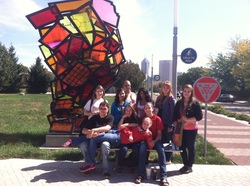 On September 27 the 2014 Mayflower Yearbook staff demonstrated their dedication to creating a great annual and departed from PHS at 6:30 a.m. Their destination was IUPUI for a full day dedicated to Yearbook! Every staff member had the opportunity to visit four different 50 minute workshops. The workshops were taught by professional Yearbook experts. Every workshop provided a new block of knowledge. Staff members learned what the Pantone color of the year is (Emerald), to how to identify staff personalities, the “do’s” and “do-do’s” when it comes to using color, a lot of tips to design awesome looking Yearbook templates, and even 45 Yearbook leadership tips!
The staff also experienced real life situations, including actually sitting in college classrooms surrounded by completely new classmates. They also experience what it's like to attend classes in a busy city like Indianapolis. To wrap up a day full of learning, they made their last stop for a late lunch at Noodles & Company, a new place for the majority of the staff. This went perfectly with the emphasis of the trip, which was to “Never be afraid of trying something new.” Monica R., PHS student 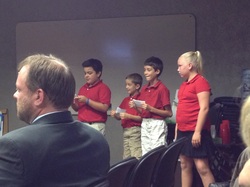 Our 4th grade students were asked to present at the latest school board meeting about the learning they have been doing on their latest project. Hannah, Billie, Nick, and William dazzled the crowd with their digital presentation and commentary about how building lifeguard chairs contributed to learning about teamwork and the power of redesign. We are so proud of them!
~Ms. Gustafson, Ms. Hebert, and Mrs. Dreibelbis |
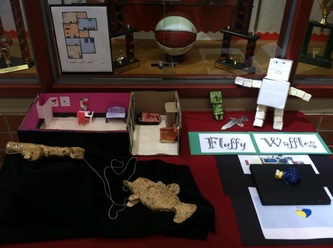
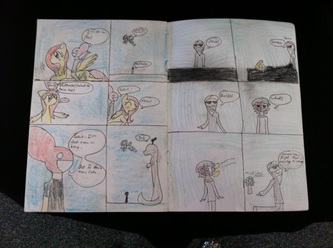
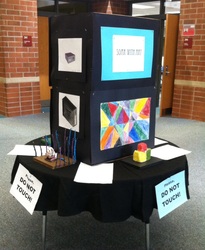
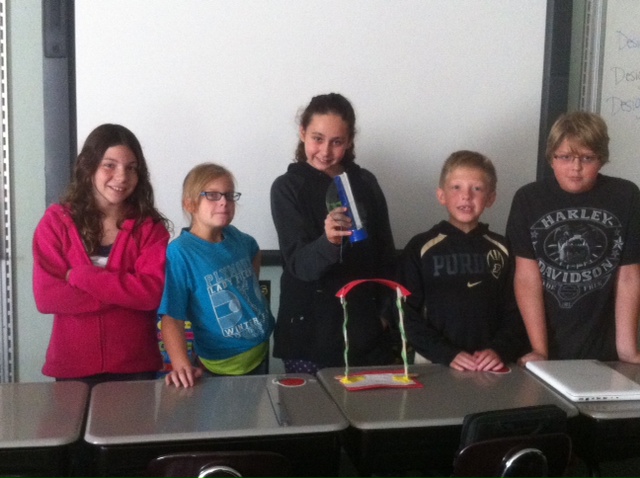
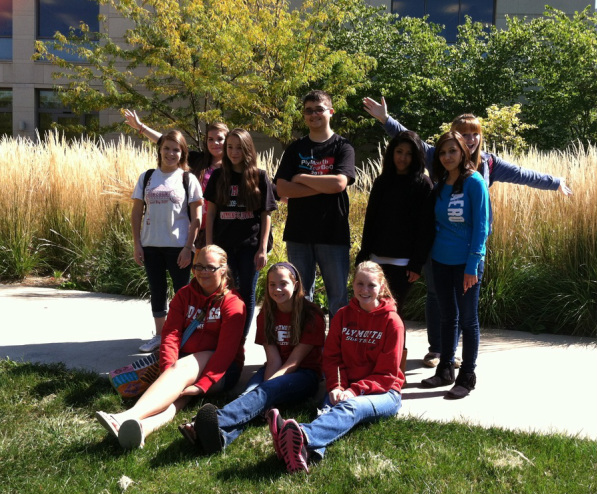
 RSS Feed
RSS Feed